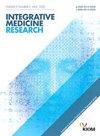A nationwide retrospective cohort study of the association between acupuncture exposure and clinical outcomes of idiopathic Parkinson’s disease using health insurance claim data in South Korea
IF 3
4区 医学
Q2 INTEGRATIVE & COMPLEMENTARY MEDICINE
引用次数: 0
Abstract
Background
Idiopathic Parkinson’s disease (IPD) has been associated with increased global mortality. While acupuncture has been reported to slow IPD progression, its effect on mortality remains unclear. This study investigated the association between acupuncture exposure and mortality, causes of death, and prognosis in patients with IPD.
Methods
Using customized cohort data from the National Health Insurance Service (NHIS), we analyzed patients newly diagnosed with IPD without disabilities between 2012 and 2016. Patients were classified into an acupuncture group (≥six sessions within 1 year of diagnosis) and a non-acupuncture group. Propensity score matching (PSM) was applied, and Cox proportional hazards models were used for survival analysis. During a 6-year follow-up, hazard ratios (HRs) were estimated for overall and cause-specific mortality, emergency room visits, fractures, and the first deep brain stimulation (DBS) procedure, using the non-acupuncture group as the reference.
Results
After PSM, 6394 patients were included in each group. The HR for mortality in the acupuncture group was 0.887 (95 % CI: 0.813−0.967), indicating a significantly lower mortality risk. Deaths due to neoplasms and digestive diseases were also lower in the acupuncture group. No significant differences were observed between groups in fracture risk, emergency room visits, or DBS procedures.
Conclusions
Acupuncture exposure was associated with a reduced mortality rate in patients with IPD. These findings suggest potential benefits of integrating acupuncture into IPD management, though further long-term randomized controlled trials are needed to confirm these results.
一项使用韩国健康保险索赔数据的针灸暴露与特发性帕金森病临床结果之间关系的全国性回顾性队列研究
背景:帕金森病(IPD)与全球死亡率增加有关。虽然有报道称针灸可以减缓IPD的进展,但其对死亡率的影响尚不清楚。本研究调查了针刺暴露与IPD患者死亡率、死亡原因和预后之间的关系。方法使用国民健康保险服务(NHIS)定制队列数据,分析2012年至2016年新诊断的无残疾IPD患者。患者分为针灸组(诊断1年内≥6次)和非针灸组。采用倾向评分匹配(PSM), Cox比例风险模型进行生存分析。在6年的随访中,以非针灸组为参照,估计了总体和原因特异性死亡率、急诊室就诊、骨折和第一次深部脑刺激(DBS)手术的风险比(hr)。结果经PSM治疗后,每组共纳入6394例患者。针刺组死亡率HR为0.887 (95% CI: 0.813 ~ 0.967),死亡率风险明显降低。因肿瘤和消化系统疾病导致的死亡率在针灸组也较低。在骨折风险、急诊室就诊或DBS手术方面,两组间未观察到显著差异。结论针刺暴露与IPD患者死亡率降低相关。这些发现表明将针灸纳入IPD治疗的潜在益处,尽管需要进一步的长期随机对照试验来证实这些结果。
本文章由计算机程序翻译,如有差异,请以英文原文为准。
求助全文
约1分钟内获得全文
求助全文
来源期刊

Integrative Medicine Research
Medicine-Complementary and Alternative Medicine
CiteScore
6.50
自引率
2.90%
发文量
65
审稿时长
12 weeks
期刊介绍:
Integrative Medicine Research (IMR) is a quarterly, peer-reviewed journal focused on scientific research for integrative medicine including traditional medicine (emphasis on acupuncture and herbal medicine), complementary and alternative medicine, and systems medicine. The journal includes papers on basic research, clinical research, methodology, theory, computational analysis and modelling, topical reviews, medical history, education and policy based on physiology, pathology, diagnosis and the systems approach in the field of integrative medicine.
 求助内容:
求助内容: 应助结果提醒方式:
应助结果提醒方式:


